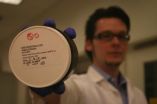Color-coded markers may help doctors diagnose neural diseases through the eyes
2012-08-15
(Press-News.org) Sticky plaques of proteins called amyloids mark several different, though related degenerative brain diseases including Alzheimer's, Parkinson's and Creutzfeld-Jacobs.
The symptoms of these disorders overlap and methods to diagnose and monitor them are not very advanced.
To solve this problem, scientists at the University of California, San Diego, have devised several new fluorescent probes that change color depending on what type of amyloid they encounter. Because amyloids accumulate in the eye as well as the brain, their discovery offers hope that one day neurodegenerative diseases could be differentially diagnosed with simple eye drops or ointment and an eye exam.
"The key trick here is that the small differences in the proteins that make up different forms of amyloid interact differently with our fluorescent probes to result in measurably different colors of the emitted light," said Jerry Yang who, along with Emmanuel Theodorakis, led the project. Both are professors of chemistry and biochemistry at UC San Diego. Christina Sigurdson from the Department of Pathology at UC San Diego's School of Medicine was a key collaborator in this work.
The colors vary depending on the physical properties of pockets in the different amyloid proteins. The team demonstrated that one of their probes glows yellow when marking amyloid deposits associated with prion disease, and green when it binds to amyloids associated with Alzheimer's disease in tissue samples, for example. Their findings are published online this week by the Journal of the American Chemical Society.
Among the few available diagnostics for Alzheimer's disease are radioactive molecules that target amyloid, which can be detected in the brain using positron emission tomography or PET scans. But that test only says whether amyloid has formed in the brain without distinguishing between the various types.
"We think that our approach represents a significant step towards developing diagnostics to distinguish between different, but closely related diseases where symptoms and pathological characteristics show may similarities," Yang said. "Such capability might prove to be very important for deciding on effective treatment strategies for specific diseases."
Now that they have learned how physical properties of amyloid control the colors of their markers, they are expanding their catalog to create probes for discriminating between other forms of amyloid.
The technology has been licensed for commercial development of diagnostic tests for human neural disease.
INFORMATION:
Co-authors include Kevin Cao, Marianna Dakanali and Willy Chang in the department of chemistry and biochemistry, and Mona Farahi in UC San Diego School of Medicine's Department of Pathology.
END
ELSE PRESS RELEASES FROM THIS DATE:
2012-08-15
For the first time, engineers at the University of New South Wales have demonstrated that hydrogen can be released and reabsorbed from a promising storage material, overcoming a major hurdle to its use as an alternative fuel source.
Researchers from the Materials Energy Research Laboratory in nanoscale (MERLin) at UNSW have synthesised nanoparticles of a commonly overlooked chemical compound called sodium borohydride (NaBH4) and encased these inside nickel shells. Their unique nanostructure has demonstrated remarkable hydrogen storage properties.
"No one has ever ...
2012-08-15
The Pipe Nebula is a prime example of a dark nebula. Originally, astronomers believed these were areas in space where there were no stars. But it was later discovered that dark nebulae actually consist of clouds of interstellar dust so thick it can block out the light from the stars beyond. The Pipe Nebula appears silhouetted against the rich star clouds close to the centre of the Milky Way in the constellation of Ophiuchus (The Serpent Bearer).
Barnard 59 forms the mouthpiece of the Pipe Nebula [1] and is the subject of this new image from the Wide Field Imager on the ...
2012-08-15
An international team of researchers has found that certain bioactive components found in human milk are associated with a reduced risk of HIV transmission from an HIV infected mother to her breast-fed infant. Their study will be published in the August 15 online edition of American Journal of Clinical Nutrition.
"In developing countries, HIV-infected mothers are faced with the decision of whether or not to breastfeed their babies," said Lars Bode, PhD, assistant professor in the Department of Pediatrics at the University of California, San Diego School of Medicine. ...
2012-08-15
DURHAM, N.C. – Researchers at Duke University Medical Center may finally have discovered why people with sickle cell disease get milder cases of malaria than individuals who have normal red blood cells.
In a finding that has eluded scientists for years, Duke researchers discovered that genetic material in red blood cells may help alter parasite activity via a novel mechanism that alters parasite gene regulation.
"One of the most interesting findings in our study is that the human microRNA (very small units of genetic material) found in sickle red cells directly participate ...
2012-08-15
Melting over the Greenland ice sheet shattered the seasonal record on August 8 – a full four weeks before the close of the melting season, reports Marco Tedesco, assistant professor of Earth and atmospheric sciences at The City College of New York.
The melting season in Greenland usually lasts from June – when the first puddles of meltwater appear – to early-September, when temperatures cool. This year, cumulative melting in the first week in August had already exceeded the record of 2010, taken over a full season, according to Professor Tedesco's ongoing analysis. ...
2012-08-15
In our zest for cleanliness, have we permanently muddied our nation's waters?
A science team from Arizona State University, in collaboration with federal partners,
has completed the first statewide analysis of freshwater bodies in Minnesota, finding widespread evidence of the presence of active ingredients of personal care products in Minnesota lakes, streams and rivers.
These products are a billion dollar industry and can be found in antimicrobial soaps,
disinfectants, and sanitizers to scrub our hands and clean countertops. Hundreds of antimicrobial products are ...
2012-08-15
New research from New Zealand's University of Otago is casting doubt on a landmark US study that suggested infants as young as six months old possess an innate moral compass that allows them to evaluate individuals as 'good' or 'bad'.
The 2007 study by Yale University researchers provided the first evidence that 6- and 10-month-old infants could assess individuals based on their behaviour towards others, showing a preference for those who helped rather than hindered another individual.
Based on a series of experiments, researchers in the Department of Psychology at ...
2012-08-15
LOS ANGELES (Aug. 14, 2012) – An experimental immune-based therapy more than doubled median survival of patients diagnosed with the most aggressive malignant brain tumor, Cedars-Sinai Medical Center researchers reported in Cancer Immunology, Immunotherapy, published online Aug. 3.
Median survival in a Phase I clinical trial at Cedars-Sinai's Johnnie L. Cochran, Jr. Brain Tumor Center was 38.4 months, significantly longer than the typical 14.6-month survival of patients with newly diagnosed glioblastoma receiving standard therapy alone, which includes radiation and chemotherapy.
Median ...
2012-08-15
Long-term methadone treatment can cause changes in the brain, according to recent studies from the Norwegian Institute of Public Health. The results show that treatment may affect the nerve cells in the brain. The studies follow on from previous studies where methadone was seen to affect cognitive functioning, such as learning and memory.
Since it is difficult to perform controlled studies of methadone patients and unethical to attempt in healthy volunteers, rats were used in the studies. Previous research has shown that methadone can affect cognitive functioning in ...
2012-08-15
A sense of fairness is an important part of human behaviour, yet a research team involving Queen Mary, University of London (UK) found it did not evolve from our closest living relatives.
The study, published in the journal Biology Letters today (15 August) tested whether our great ape relatives, the chimpanzees and bonobos, have a sense of fairness like humans.
The scientists, involving Professor Keith Jensen, from Queen Mary's School of Biological and Chemical Sciences, put the apes through a series of ultimatum games.
One against the other, they had to choose ...
LAST 30 PRESS RELEASES:
[Press-News.org] Color-coded markers may help doctors diagnose neural diseases through the eyes



